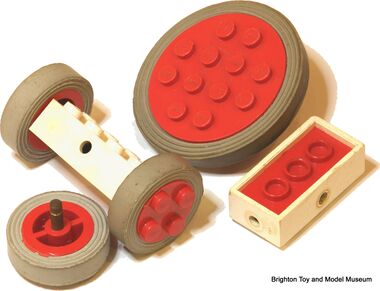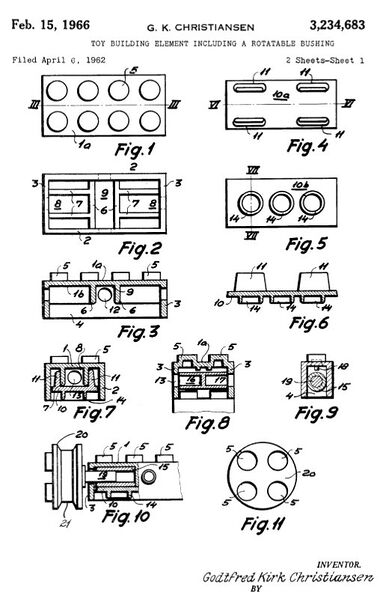Category:Lego wheels
Bricks: Original
|| Transitional
|| Modern
Town Plan
|| Cars
|| Roofs
|| Windows and Doors
|| Wheels
Lego Wheels and Axles, closeup [image info]
1962: Patent application 3234683 [image info]
Lego produced their first wheels in 1962, with the appearance of the accessory pack 400.
- Pack 400 included two axle bricks and four small wheels with grey tyres. It also included a small baseplate and a flexible coupling, which was enough to let you use the rest of your Lego to make a small four-wheeled car, and to have a coupling dangling for the back for a trailer (for which you'd of course need to buy another wheel set ...).
- Pack 401 had two axle bricks and just two of the larger-size wheels (and the flexible coupling).
- Pack 402 contained three turntable bricks and a couple of four-by-eight baseplates.
Additionally,
- Set 314 proudly displayed examples of all of the new rotating pieces in a large display box, as a sort of presentation set.
The Turntable Brick
The arrival of the turntable brick is perhaps slightly anomalous: its upper surface has the same stud layout as the Large Wheel, so why not just use a Large Wheel, and make use of the lower-friction axle bricks?
Unfortunately, while the axle bricks had four ports, and accepted wheels at all four vertical faces, you couldn't plug a wheel into the top or bottom and have it mounted horizontally, so you couldn't have a nice red wheel acting as the ladder turntable of your nice red Lego fire engine. Since 1960s Lego was still very much designed with "studs on top", and didn't have any right-angle adaptors or hinges that could be used to rotate an axle brick onto its side, using a wheel as a turntable would have required required a new turntable brick with a hole on top (and/or underneath). Lego seem to have decided that if they were going to have to design a new turntable brick, that they might as well produce a more compact dedicated turntable piece that worked without needing a separate wheel, and which (because it didn't need flanges to hold tyres) could be compact enough to completely fit inside a four-by-four space.
The turntable joint was comparably high-friction and didn't encourage free movement. This was both good and bad: It meant that a crane jib or fire engine ladder tended to stay pointing where you left it, and wouldn't swing wildly about when the model was tilted ... but it also meant that the deliberate effort of rotating the turntable took some of the spontaneous joy out of playing with the resulting model. One didn't get the sense that one was dealing with an engineered joint, whereas if they'd gone down the axle and wheel route, you could have rotated even a strongly loaded turntable joint with light fingertip pressure.
Another option might have been to produce a lower-friction turntable with four "click" positions at 90-degree angles, so that a fire engine ladder would stay lined up with the vehicle body when it was driving, but when clicked out of position would give 90 degrees of free movement.
The limited uses of the turntable brick meant that it was initially only available in white. For users with no need of turntables, the brick had other uses, such as making solid bases for round castle towers.
Significance
The appearance of the wheel sets helped sign the death knell for the original "City Plan" focus of Lego System. Rather than buy a little readymade Lego 1:87 model to go in a tiny Lego garage, one could have the additional fun of actually building your own car, to your own design, using the bricks you had available. Because of the size of the wheels, the resulting toy cars would be vastly out of scale with the Town Plan road system and buildings – a small Lego wheel was about the height of one storey of a Town Plan building.
The appearance of the wheel parts also meant the (eventual) disappearance of the Lego 1:87 plastic car range. While the little cars were nominally "Lego System", they weren't "Lego" in the sense that most people understood, and only really "connected" to the rest of the Lego System via the card town plan baseboard.
The Lego wheels (and dedicated sets using them) were followed by the Lego Train system (inevitably also far larger than 1:87), and the idea of there being a single usable scale for Lego models fell by the wayside.
External links
Pages in category ‘Lego wheels’
The following 3 pages are in this category, out of 3 total.
Media in category ‘Lego wheels’
The following 5 files are in this category, out of 5 total.
- Large Wheels, Lego Set 401 (Lego ~1964).jpg 702 × 976; 87 KB
- Lego wheel and axle design (Patent 3234683, s1962).jpg 508 × 795; 87 KB
- Lego wheels and axles (Lego, 1960s).jpg 3,000 × 2,294; 398 KB
- Small Wheels, Lego Set 400 (Lego ~1964).jpg 702 × 976; 70 KB
- Turntables, Lego Set 402 (Lego ~1964).jpg 702 × 976; 69 KB









